Menu
It is very upsetting to see the things we care about suffering because of climate change. Many people are working to change this, but action has been slow. In this video, Dr Philippa McCormack talks about how we can protect our endangered animals in Australia. You might also like to look at this answer about why getting societies to take action is so hard.
Thank you for your question. I think there are two different parts to your question.
The first one may relate to weather rather than climate. Weather and climate are not the same thing. Weather is what happens from one day to the next, and yes, it certainly does change a lot, especially in Tasmania. Climate is the average weather over time.
Let’s talk about weather in Tasmania first. Our weather is affected by processes on a range of scales, and by other factors. One of these important factors in Tasmania is what we call topography – or land form. We have a lot of mountains in the west that rise up to Central Plateau and then in the east the land is generally flatter and lower elevation. Tasmania sits in a region known as the ‘Roaring Forties’ and most of our weather comes from the west
due to the way the atmosphere is ‘organised’. This means that when weather systems hit the west, they drop most of their rain in the west because the clouds carrying the rain have to rise up to get over the mountains. There’s often not much left by the time they get over the Central Plateau.
Another factor is that Tasmania is only a small island. You’ve probably seen weather maps like the one below. Low and high pressure systems pass over Tasmania. Air circulates clockwise around a low pressure system and anticlockwise around a high pressure system. Think about the low pressure system in the map that’s passing over southeastern Australia. If air circles clockwise around this system it means its picking up a lot of moisture from the Tasman sea which then gets dumped along eastern Australia, including Tasmania. As it moves further east – due to dominant westerly winds – we will start to get colder air from further south. If we had a high pressure system passing over Tasmania instead, we would first see winds from the south and then as it passed further to the east, the wind would come from the north. Winds from the north are warmer than winds from the south. Slightly
different locations (e.g. whether they are further south or further north) will also make a difference. So, our weather changes as one system passes over us and sometimes we can get four seasons in one day.
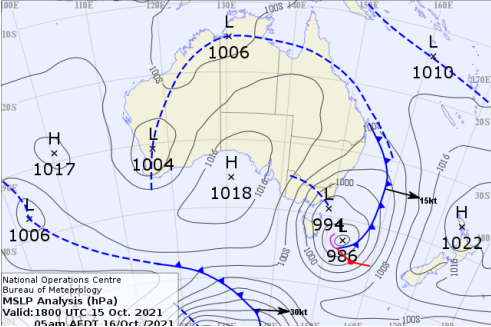
Now, in relation to a constantly changing climate. When we talk a about a changing climate, we’re talking about longer time scales. How long depends on your perspective. For example, people who work with just data that has been measured over the past century would look at trends and change over the past century. Others who study what we can find out about climate from things like sediment, ice cores, tree-rings or corals will look at how climate has changed over hundreds or thousands of years. Some people will look at changes in rainfall and others might look at changes in temperature over land or temperature of the sea.
Just a few things that affect climate over different time scales are:
Since the 1950s the rate of plastic production has rapidly increased. This has led to a rapid increase in the amount of plastic we find in our bins and unfortunately, the environment. It is expected that our global plastic use will double by 2040. Historically, Australia has not been very good at reducing or recycling our plastic waste with 13% of all plastic waste recycled and around 130,000 tonnes of leaking into the marine environment. In 2021, the Australian Government introduced a plan called “The National Plastics Plan” to:
So, although historically Australia has had low recycling rates for plastics, the 2021 plan aims to take strong action to reduce plastic waste in our bins and the environment.
There are three parts to this question. The first one relates to the role of government, as opposed to the role of private sector in reducing carbon emissions and carbon dioxide concentrations in the atmosphere. The second part relates to role of Carbon Capture Technology, and indeed how we define this technology. The third part is the role of taxes in funding government initiatives.
Governments, such as the Australian Government, have an important role in providing public goods, such as a safe climate. They can support the provision of this public good by working with the private sector in helping them reduce carbon emissions at source (i.e. where they are emitted, such as through ‘smoke stacks’). Government assistance can take the form of public funding to develop new technologies to capture carbon at source, or to reduce carbon dioxide concentrations in the atmosphere, such as through reforestation and wetland regeneration.
This leads to the second part of my response, involving Carbon Capture Technology. Can this ‘technology’ involve activities such as reforestation and wetland regeneration? I work on wetland restoration projects that are funded by the Australian Government specifically to reduce carbon dioxide concentrations in the atmosphere. Wetlands do this by removing atmospheric carbon and storing it safely in their soils and lifeforms as ‘blue carbon’. Investing in these so called ‘nature-based solutions to climate change’ has the added benefits of conserving our biodiversity, and supporting food webs that in turn benefit fisheries.
But does the Australian Government need taxes in order to fund these initiatives, whether they involve smoke stacks or salt marshes? We know the answer is ‘no’ from the COVID19 experience from 2020, where the Australian Government did not need to tax us in order to fund their responses to the pandemic. Taxes have a number of functions in Australia, but we do not need to tax before we can spend/fund. If the Australian Government wants to fund climate change responses, the limiting factor is not taxes, but a combination of political will and imagination (if you like, ‘thinking outside the tax’).
This is a very good question. Climate has always changed. The problem is that now human actions are changing the climate in ways that it would not have changed under just natural conditions. Through increasing greenhouse gases in the atmosphere, humans have increased Earth’s temperature very rapidly. Rapidly increasing temperatures mean that fire seasons are getting longer, so large-scale fires are becoming ‘more normal’. Drought is also likely to become more common in some regions and floods more common in other regions. It is much harder time trying to understand what is likely to happen with rainfall compared with temperature, though. These rapid changes in climate mean many plants and animals don’t have time to adapt and many ecosystems are showing signs of collapsing. In many cases, these changes will also likely lead to an increase in ‘pest species’ (e.g. fruit fly).
The rate of temperature increase over the past 70 or so years has been alarming. Climate model projections suggest that in less than a century –if we continue doing what we are doing and don’t change –temperatures may be as high as they were millions of years ago.
The image below shows how temperature changed over geological time, from around 60 million years before today. In the image, Myr means millions of years and Kyr means thousands of years. The modern end shows how climate models suggest the temperature will change into the future up to 2250. Climate models use a lot of physics and maths and what we know about how climate works to project into the future. When scientists look at the models, they consider what global temperatures might look like if humans took slightly different courses of action:
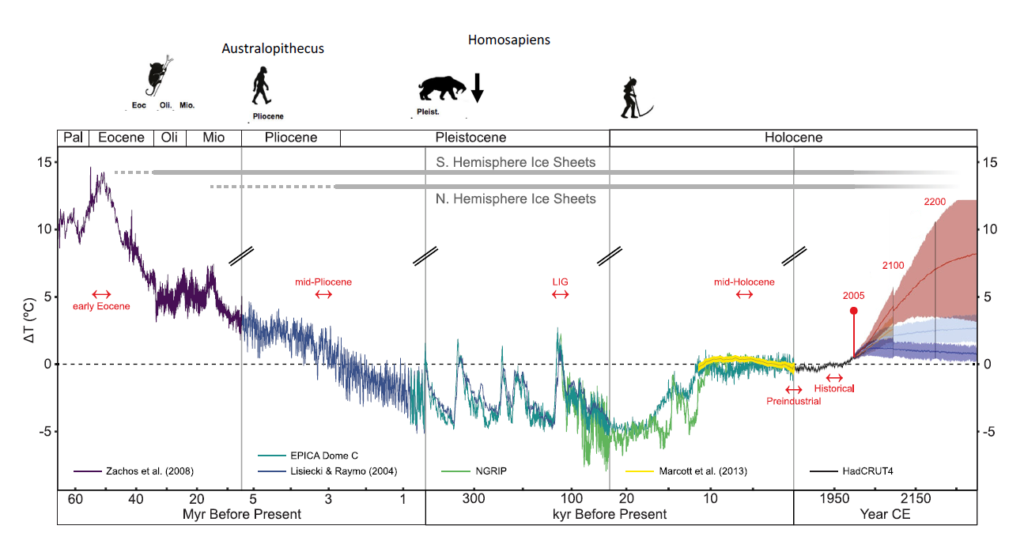
At the moment, we really aren’t doing much to reduce greenhouse gas emissions that are making temperatures rise very quickly. This suggests that if we want to know what conditions might be like in 2200, we have to look all the way back to what is known as the ‘palaeocene-eocene thermal maximum’ around 50 million years ago. This was a period long before homo-sapiens (our own species) existed. Life on Earth was very very different. There were no ice caps and many of the ecosystems we see today didn’t exist. If, however, we take urgent action to address climate change, the ‘nearest’ similar climate is the Last Interglacial period (LIG in the diagram) which was ‘only’ around 126,000 years ago.
Conditions and life forms at either of these times were not like those we see today. If we change the climate to this extent, we will see some land (like a lot of Pacific islands and low lying coastal areas) disappear under water, terrible devastation of coastal cities (including in Australia and Tasmania), and much human suffering. We will also lose many important ecosystems on which we rely for food. As thing becomes much more difficult we can expect increased conflict as people fight over diminishing resources. So, climate change has really significant implications. Not just for humans, but all species currently on the planet. The pace of change means that the ability to adapt is limited for most species.
Carbon in the atmosphere is a natural part of the carbon cycle. The problem though, is that through human activities, we are putting too much carbon in the atmosphere. There are many natural ways that carbon is captured from the air. Plants on land and in the ocean, all photosynthesise which takes carbon from the atmosphere. These are what we could call the ultimate and natural carbon catchers.
Scientists are working hard to develop effective approaches to capture the carbon that is produced from industrial processes such as power plants, and other carbon emitting activities like deforestation and agriculture. The challenge though is knowing what to do with it once it is captured. Storage solutions are needed but generally these are very expensive, and we don’t really know all of the environmental risks associated with them. For example, some ideas are to trap the carbon dioxide deep into the ocean, or to store it underground in rocks or in minerals. Each has a number of known and unknown risks which need to be carefully addressed before anything is pursued on a large scale.
Resource: https://scied.ucar.edu/learning-zone/climate-solutions/can-we-pull-carbon-dioxide-out-atmosphere
This is a complex question. It is the sort of question we love to answer in science! But it is also a question that, when answering, can cause uncomfortable emotions. Before I go into this, I want to emphasise that I am genuinely optimistic about the future. As a species, our actions have changed the world, and will continue to change the world for some time. However, we are currently aware of the problems and there is an enormous movement of people working towards solutions.
In my branch of science – ecology (which is the study of interactions between living things and their physical surroundings) – the word environment describes any area in which an organism (or living thing) exists. Broadly, when a group of organisms rely on each other for survival and are dependent on particular environmental features, we call it an ecosystem. To clarify your question, environments change, but ecosystems die. We know why some of our ecosystems are dying, and I will try to outline some of the key causes below.
1: Greenhouse gas emissions and the deforestation of old growth forests.
Arguably more than any other cause, our emission of greenhouse gases drives shifts in our climate. They are called greenhouse gases because, in large quantities, they cause the planet to warm like a greenhouse.
Almost everything in nature endures when balanced. To paint a picture of global cycles, you can think of everything that releases gas as a pair of human lungs, and everything that stores gas as a tree. You know how when you breathe, you inhale oxygen, and then exhale carbon dioxide – but at the same time trees inhale carbon dioxide and exhale oxygen? Well, to an extent, the same balance exists in nature: There are things that naturally exhale greenhouse gases – such as volcanoes, bushfires, and animals (these can be thought of as the human lungs in our example). There are also things that naturally inhale greenhouse gases – such as plants, algae, and fungi (these can be thought of as the tree in our example). Normally, these things tend to balance each other, with the lungs breathing as much as the tree.
However, over the past century, humans have greatly reduced the number of trees on our planet, and artificially increased the amount of gas being released. This has destroyed the balance. What I mean by this is, where our example lungs used to contain gases only from natural sources (volcanoes, bushfires, animals, etc.), it now contains gases from sources that would never have been part of the global cycle. This is because these gases are released from the burning of fossil fuels – oil and other substances that are naturally locked deep underground. By digging these underground features out of the earth and burning them, we release more gas than our example tree (plants, algae, and fungi) is able to breathe. If the tree can’t breathe these gases in time, they get stuck in our atmosphere and cause greenhouse warming – heating the planet and disrupting every type of ecosystem.
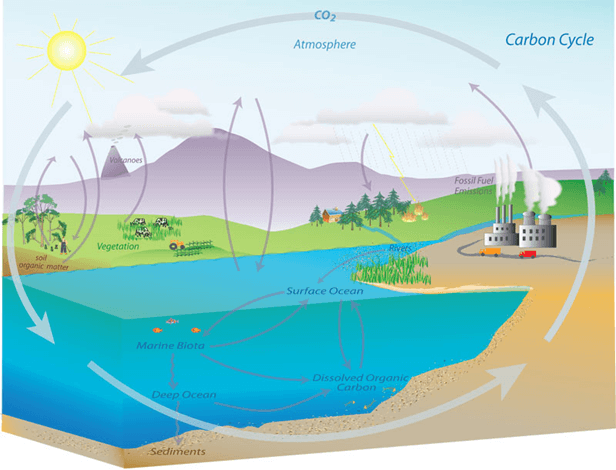
2: Pollution
Environmental pollution exists in many forms, including chemical, pharmaceutical, and atmospheric. But the form that most people are familiar with, is plastic pollution. Plastic is an incredibly useful material, and that means that it is present in many of our household items. Unfortunately, plastic takes an enormous amount of time to break down in nature (I talk about this in another answer on the Curious Climate website: https://curiousclimate.org.au/schools_experts/benjamin-viola/).
One thing I didn’t talk about however, was that large pieces of plastic can look like prey items to animals. When they eat this plastic, it can get stuck in their bodies and potentially cause lethal harm. Animals are a crucial part of healthy ecosystems, and if too many animals die, it can have compounding flow on effects that alter entire ecosystems. For more information on this, check out the trophic cascades page on Wikipedia (I know it isn’t recommended to use Wikipedia for homework, but we all do…): https://en.wikipedia.org/wiki/Trophic_cascade
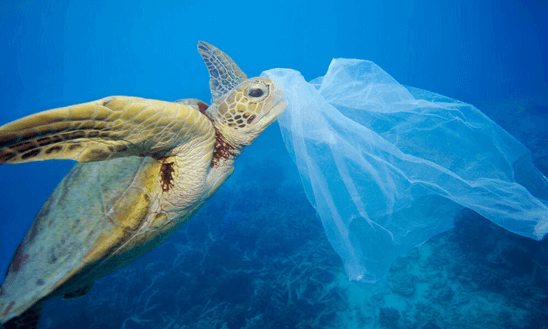
3: Invasive species
With colonisation, seafarers from around the world brought plants and animals from their land to other countries. These plants and animals (referred to as exotics) sometimes escaped and established feral populations. Feral species have an enormous impact on local ecosystems as they disrupt cycles that have established over thousands of years. For instance, the introduction of Cane Toads in Australia has pushed many native species towards the brink of extinction.
Cane Toads were introduced with the intention of protecting sugar cane crops from Cane Beetles. It was thought that Cane Toads would eat the Cane Beetles, and the crops would benefit from fewer Cane Beetles consuming sugar cane. Unfortunately, the Cane Toad didn’t eat the Cane Beetles, and given that the toads are toxic at all stages of their life cycle, many Australian species that consume Cane Toads die.
For example, the Northern Quoll was once widespread in Northern Australia, but since the introduction of the Cane Toad, it is now an endangered species. Cane Toads continue to spread throughout Australia. They aren’t able to survive in colder areas, but as the climate warms, they are capable of expanding to increasingly more regions. You can read more about this species and its impacts from a number of sources, but the New South Wales government has a great webpage on them.
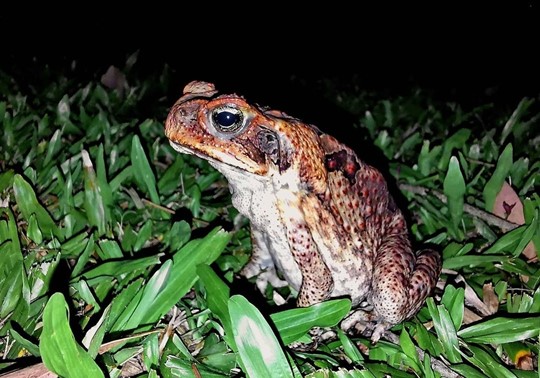
The short answer is no. However, reefs will change from how we know them today. When considering reefs, the two major types of reef in Australia are tropical coral reefs and temperate rocky reefs, home to kelp forests. Both these reef systems are sensitive to ocean warming and marine heatwaves and both have experienced extreme impacts in the past decade. For example, almost 100,000 Hectares, equivalent to 2.3 million basketball courts of kelp forests were lost in Western Australia in 2011 following an extreme marine heatwave. In the tropics, marine heatwaves in 2016 and 2017 resulted in severe coral bleaching and death on the Great Barrier Reef.
As oceans warm, these extreme events will become more frequent and species that are already living close to their upper thermal limits are likely to suffer. In Australia, species on both coral reefs and kelp forests have evolved for millions of years under remarkably stable climate conditions. Unlike on land where temperatures can fluctuate by over 30ºC in a year, in the oceans around Australia, temperatures may only fluctuate by 5-10ºC. As a consequence, many species have limited scope to deal with changes in temperature. On top of this, south-eastern and south-western Australia are warming 2-4 times faster than average, making these regions particularly vulnerable to change.

In response to changing ocean conditions, species can either move to cooler habitats, adapt, or die. Many species are unable to move or adapt fast enough to escape the warming, or the impacts of a sudden marine heat wave. For the species that can move elsewhere, they may be able to survive in their new habitat, but in doing so may be lost from the reefs they have departed. As a result, there will be a change in the types of species that we see on reefs, with increasing numbers of warm water species in places like Tasmania, and a loss of the traditional cool-water species. Giant kelp is one example of this, which has decreased by 95% on Tasmanian reefs in recent decades. Even in the tropics, many heat tolerant species will survive, but it might not be all the colourful corals and fishes that we think of today.
This is a really great question. The answer is that animals do not often change their habitat, but they are very likely to change where they live.
A habitat is a place where an animal lives. A habitat has plenty of shelter and food for the animal, but it is also where the environment is really good for the animal, not too hot or not too cold. Different animals have different adaptations or characteristics that allow them to live in one area, and this is why we do not see the same animals everywhere. For example, camels can live in the dessert because they can tolerate high temperatures that other animals (including humans) cannot.
Climate change can affect the environment in one area, which can affect the amount of food and shelter available to animal in that area. If the environment changes too much, animals may not have enough to eat, so they will need to move or migrate to other habitats, where there is good food, shelter and a nice environment.
There is another way animals can survive climate change: evolution. You may have heard of evolution in class and about a scientist called Charles Darwin, who came up with this idea. If you have not yet, you can read this entry in the Encyclopedia Britannica. In short, evolution are changes in the genes of an animal that affect their body or behaviour. These changes help the animals to adapt to their new habitats, so they are more likely to survive and have babies, which means their genes continue to be passed along.